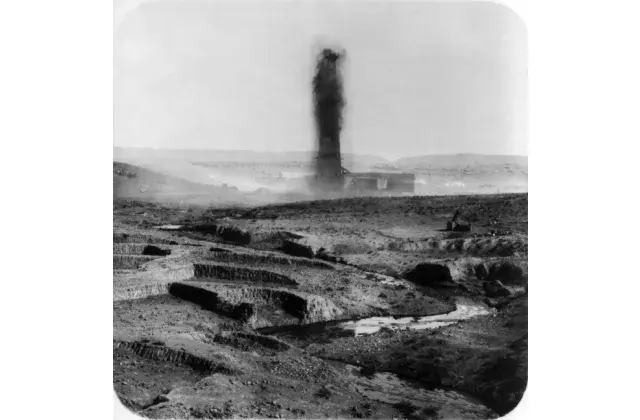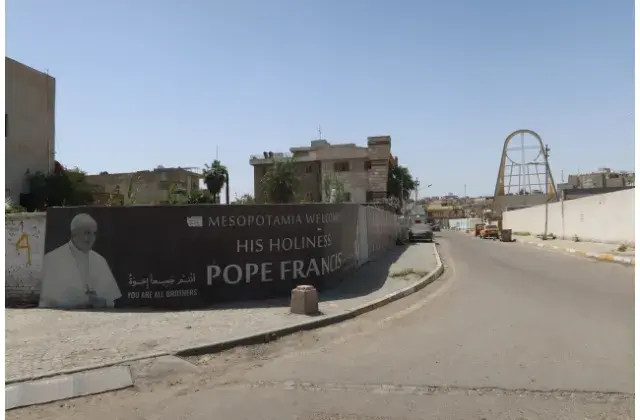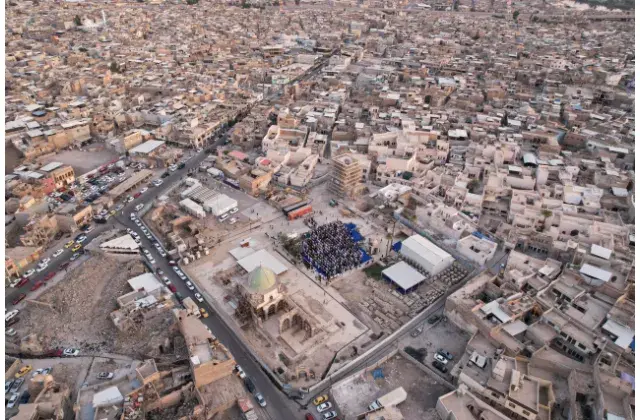گێرترود بێڵ و مێژووی مۆزەخانەی عێراق (١٩٢٠ - ٢٠١٥)

سەرهەڵدانی دەوڵەتی هاوچەرخی عێراق پەیوەندییەکی نزیکی بە گێرترود بێڵ (١٨٦٨-١٩٢٦)ەوە هەیە، کە شوێنەوارناس، نووسەر و گەشتیار و دواتر دیپلۆماتکاری کۆلۆنیالی بەریتانی بووە. بەهۆی شارەزایی لە زمانی عەرەبی و شارەزایی لە هۆز، جوگرافیا و سیاسەتی ناوچەکە، کاریگەرییەکی زۆری لەسەر داڕشتنی سیاسەتی ئیمپراتۆریەتی بەریتانیا هەبوو. بێڵ بوو کە پێشنیاری بۆ ئینگلیزەکان کرد حوسێن کوڕی عەلی، شەریفی مەککە، لە ساڵی ١٩١٦ لە سەردەمی جەنگی جیهانی یەکەمدا سەرکردایەتی ڕاپەڕینی عەرەب بکات دژی ئیمپراتۆریەتی عوسمانی و فەیسەلی کوڕی وەک یەکەم پاشای عێراق دەستنیشان بکات. زانیارییەکانی لە ئەنجامی گەشتە جۆراوجۆرەکانی بۆ سەرتاسەری ناوچەکە و کارەکانی وەک شوێنەوارناسێک بوو. بۆ نموونە، لە ساڵی ١٩٠٩ هەڵکۆڵینەکانی لە قەڵای ئەل ئخێدر لە نزیک کەربەلا لە عێراق ئەنجامدا و یەکەم ڕاپۆرتی گەورەی لەسەر پاشماوەکان بڵاوکردەوە.
خاکی نێوان دوو ڕووبارەکە مێژوویەکی دوورودرێژی هەیە و چەندین شوێنەواری گرنگی تێدایە. لە سەردەمی حوکمڕانی عوسمانیدا زۆر هەڵکۆڵین ئەنجامدرا بەبێ ئەوەی بە فەرمی لەلایەن هیچ دەسەڵاتێکەوە تۆمار بکرێن. پاش ماوەیەکی کورت لە گرتنەوەی بەغدا لە ساڵی ١٩١٧، ژەنەڕاڵ مۆد ڕاگەیاندراوێکی دەرکرد بۆ ڕێکخستنی پاراستنی شوێنەوارەکان و بازرگانی بەشی ئاسەوارە دێرینەکان. پەیماننامەی ئەنگلۆ-عێراقی ساڵی ١٩٢٢ جێبەجێکردنی یاسای بەشی ئاسەوارە دێرینەکانی لەخۆگرتبوو لەسەر بنەمای ئەو ڕێسایانەی کە هاوپێچی مادەی ٤٢١ی پەیماننامەی ئاشتی ساڵی ١٩٢٠ی بوو کە لە سیڤەر وارژۆکرا. دوای ماوەیەکی کەم لە دروستکردنی بەشی ئاسەوارە دێرینەکان لەگەڵ بێڵ کە ئەو کات سکرتێری ڕۆژهەڵات بوو، دواتریش بەڕێوەبەری فەخری. یەکسەر دەستی کرد بە کارکردن لەسەر یاساکە کە دواجار لە ساڵی ١٩٢٤ پەسەندکرا. یاساکە زۆر ئاسانکاری بەرامبەر بە شوێنەوارناسە بیانییەکان دەکرد و کردەوەی ئەوەی بەڕێوەبەری گشتی ئەو کەلوپەلانە هەڵبژێرێت کە بە هەڵکۆڵەرە بیانییەکان دەدرێت؛ پرسێک بوو زۆر مشتومڕی لەسەر بوو. لە هەمان کاتدا دڵنیایی دا لەوەی کە مۆزەخانەکە لە ماوەیەکی زۆر کورتدا پڕ دەبێت لە کەلوپەلی نایاب بە کەمترین تێچوو بۆ حکومەتی عێراق.
لە ساڵی ١٩٢٣، گێرترود بێڵ توانی ئیدارە ڕازی بکات کە دوو ژووری لە فەرمانگەکانی حکومەت لە بینای سەرای (ئەمڕۆی ئەلقشلە) بداتێ – بەم شێوەیە مۆزەخانەی عێراق لەدایکبوو. بەهۆی گەشەسەندنی بەردەوامی کەلوپەلی کۆکراوە ، بێڵ بەدوای شوێنێکی گەورەتردا دەگەڕا بۆ ئەوەی کۆمەڵەکە هەڵبگرێت. لە ساڵی ١٩٢٦، باڵی یەکەمی مۆزەخانەی عێراق لە باڵەخانەیەکی دوو نهۆمی لە شەقامی مەئموون (مۆزەخانەی ئەمڕۆی بەغدادی) دەرگاکانی کردەوە. بێڵ دوای ماوەیەکی کەم لە کردنەوەی مۆزەخانەکە کۆچی دوایی کرد. وەک بەڕێوەبەری فەخری بەشی ئاسەوارە دێرینەکانی عێراق، هەستا بە نوێکردنەوەی ڕێکارەکان و کەتەلۆگی دۆزراوەکان کە خەریک بوو دەبنە ستاندارد لە سەرانسەری جیهاندا.
لە ساڵی ١٩٣٦ یاسای نوێی شوینەوارەکان دڵنیایی دا کە هەموو کەلوپەلە دێرینەکان و شوێنەوارەکان لە عێراق ببنە موڵکی دەوڵەت. مۆزەخانەکە بەردەوام بوو لە وەرگرتنی شوێنەوار، بەڕێوەبەرایەتی گشتی شوینەوارەکان بڕیاریدا کۆمەڵگایەک بۆ مۆزەخانە دروستبکات، بۆ نمایشکردنی تەواوی کۆکراوەکان هەروەها دانانی شوێنێک بۆ نووسینگە کارگێڕییەکانی. تا ساڵی ١٩٣٩ زەویەکەی لە بەڕێوەبەرایەتی هێڵی ئاسنین وەرگیرا، کە پێکهاتووە لە ٤٥٠٠٠ مەتر چوارگۆشە لە قەزای ساڵحیە، کە شوێنی ئێستای مۆزەخانەکەیە. تەلارسازی ئەڵمانی ڤێرنەر مارچ دیزاینی کۆمەڵگای مۆزەخانەکەی لە پێکهاتەیەکی ئارت دیکۆ دیزاین کردووە کە لەگەڵ پلانی خانووە کولتوورییەکانی عێراق دەگونجێت. , بنیادنان پێش جەنگی جیهانی دووەم دەستی پێکرد بەڵام لە ساڵی ١٩٤٠ تا ساڵی ١٩٥٥ بەهۆی جەنگەوە وەستا، لە ساڵی ١٩٥٧ شا فەیسەڵی دووەم بەردی بناغەی کۆمەڵگا نوێیەکەی دانا، کە لە ساڵی ١٩٦٣ تەواو بوو.
لە ساڵی ١٩٦٣ تا ساڵی ١٩٦٦ ستافی مۆزەخانەکە زیاتر لە ١٠٠,٠٠٠ پارچەیان نمایشکرد کە لە ١٥ هۆڵی پێشانگادا ڕێکخرابوو. سەرەڕای ئەوەش، کۆمەڵگاکە کتێبخانەیەکی دەوڵەمەندی فرە زمانی لەخۆگرتبوو کە هۆڵێکی ٢٥٠ کەسیی تێدابوو. مۆزەخانەی عێراق لە ساڵی ١٩٦٦ بە فەرمی کرایەوە. لە ساڵی ١٩٨٤ کۆمەڵگای مۆزەخانەکە بە هاوپێچێکی نوێ (مۆزەخانەی نوێ) فراوانکرا، کە ٨ هۆڵی پێشانگای تێدابوو. مۆزەخانەی عێراق لە ساڵی ١٩٩١ داخرا کاتێک بەهۆی هێرشی بۆمبەوە کە نزیک سەنتەری تۆڕی پەیوەندی و تەلەفزیۆنی بوو، لە کاتی ئۆپەراسیۆنی زریانی بیابان بە سەرکردایەتی ئەمریکادا زیانی پێگەیشت، بەڵام لە ساڵی ٢٠٠٠ دووبارە کرایەوە. دوابەدوای داگیرکردنەکەی ساڵی ٢٠٠٣ مۆزەخانەکە و کۆکراوەکانی مۆزەخانەکە بوونە قوربانی تاڵانکردن کە لە سەرانسەری وڵاتدا ئەنجامدرا. دوای چەندین ساڵ لە کاری نۆژەنکردنەوە کە بە هاوکاریی و پاڵپشتی نێودەوڵەتی ئەنجامدرا، مۆزەخانەی عێراق توانی لە شوباتی ٢٠١٥ بکرێتەوە. لە ئێستادا لەلایەن وەزارەتی ڕۆشنبیری و گەشتوگوزار و شوێنەواری عێراقەوە بەڕێوەدەبرێت.
هذا المحتوى مرخص بموجب رخصة المشاع الإبداعي CC BY-NC 4.0.






